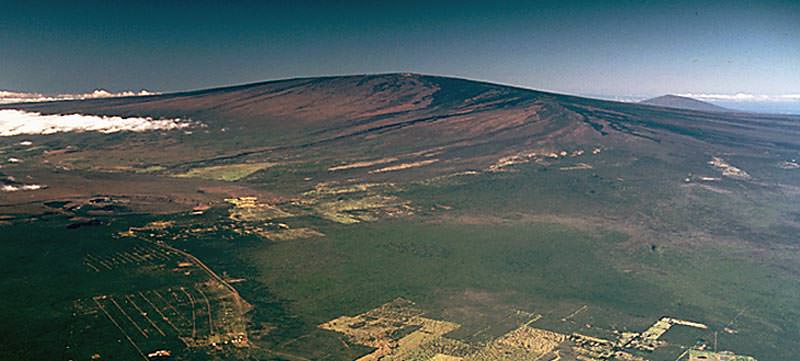[/caption]
Earth’s largest volcano is Mauna Loa, located on the Big Island of Hawaii. Although it only rises 4 km above the surface of the Pacific Ocean, that’s just the tip of the iceberg. Mauna Loa descends another 5 km down to the sea floor, which has been pushed down another 8 km by the mass of Mauna Loa. When you add that all up, the summit of Mauna Loa is 17 km above its base. It’s not the tallest volcano on Earth, though, it’s actually 37 meters shorter than Mauna Kea.
Half of the island of Hawaii is made up by Mauna Loa, and it amounts to 85 percent of all the other Hawaiian islands combined. Scientists believe that Mauna Loa has been erupting for at least 700,000 years, and may have emerged above sea level 400,000 years ago. Furthermore, Mauna Loa is one of the world’s most active volcanoes having erupted 33 times since detailed records began in 1843. Its most recent eruption was in 1984, and it’s almost certain to erupt again in the near future.
As with all of the Hawaiian volcanoes, Mauna Loa gets its magma from the Hawaiian hotspot. This is a chamber of magma that has created all the islands in the Hawaiian archipelago. The slow movement of the Pacific Plate has created a succession of volcanic islands that stretch thousands of km across the ocean. Nearby Mauna Kea is dormant, Mauna Loa is active and the smaller Kilauea is in an almost constant state of eruption.
Mauna Loa is a shield volcano. This means it has wide, gently sloping flanks. The basalt lava that erupts out of Mauna Loa and the other Hawaiian Islands has a high viscosity, and can flow for dozens of kilometers. Explosive eruptions on shield volcanoes are rare. Scientists have detected a magma chamber about 3 km below the surface of Mauna Loa, and smaller chambers beneath rift zones on the volcano’s flanks.
We have written many articles about volcanoes for Universe Today. Here’s an article about Kilauea, and here’s an article about Krakatoa.
Want more resources on the Earth? Here’s a link to NASA’s Human Spaceflight page, and here’s NASA’s Visible Earth.
We have also recorded an episode of Astronomy Cast about Earth, as part of our tour through the Solar System – Episode 51: Earth.

